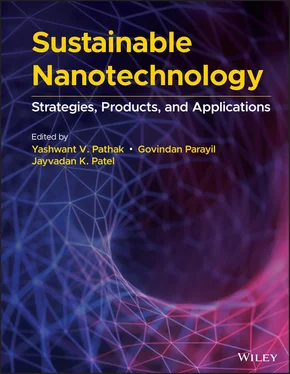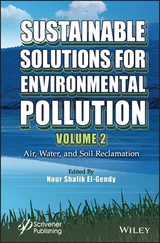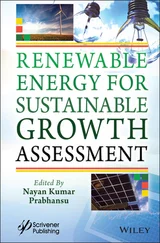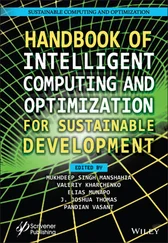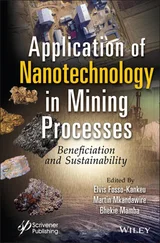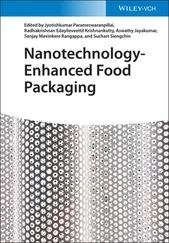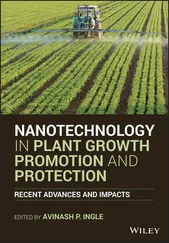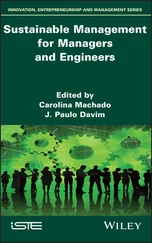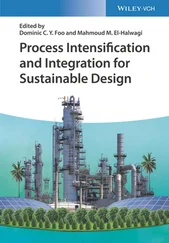Sustainable Nanotechnology
Здесь есть возможность читать онлайн «Sustainable Nanotechnology» — ознакомительный отрывок электронной книги совершенно бесплатно, а после прочтения отрывка купить полную версию. В некоторых случаях можно слушать аудио, скачать через торрент в формате fb2 и присутствует краткое содержание. Жанр: unrecognised, на английском языке. Описание произведения, (предисловие) а так же отзывы посетителей доступны на портале библиотеки ЛибКат.
- Название:Sustainable Nanotechnology
- Автор:
- Жанр:
- Год:неизвестен
- ISBN:нет данных
- Рейтинг книги:3 / 5. Голосов: 1
-
Избранное:Добавить в избранное
- Отзывы:
-
Ваша оценка:
- 60
- 1
- 2
- 3
- 4
- 5
Sustainable Nanotechnology: краткое содержание, описание и аннотация
Предлагаем к чтению аннотацию, описание, краткое содержание или предисловие (зависит от того, что написал сам автор книги «Sustainable Nanotechnology»). Если вы не нашли необходимую информацию о книге — напишите в комментариях, мы постараемся отыскать её.
A robust examination of the use of nanotechnology in the manufacture of sustainable products Sustainable Nanotechnology: Strategies, Products, and Applications
Sustainable Nanotechnology: Strategies, Products, and Applications
Sustainable Nanotechnology — читать онлайн ознакомительный отрывок
Ниже представлен текст книги, разбитый по страницам. Система сохранения места последней прочитанной страницы, позволяет с удобством читать онлайн бесплатно книгу «Sustainable Nanotechnology», без необходимости каждый раз заново искать на чём Вы остановились. Поставьте закладку, и сможете в любой момент перейти на страницу, на которой закончили чтение.
Интервал:
Закладка:
Table of Contents
1 Cover
2 Title Page
3 Copyright Page
4 Dedication Page
5 List of Contributors
6 Preface
7 Foreword
8 1 Nanotechnology‐Based Research Priorities for Global Sustainability 1.1 Introduction 1.2 Medicine 1.3 Food and Agriculture 1.4 Human Health and the Environment 1.5 Industry 1.6 Further Training 1.7 Conclusion References
9 2 The Road to Sustainable Nanotechnology: Challenges, Progress, and Opportunities 2.1 Introduction 2.2 Road to Sustainability in Nanotechnology 2.3 Development of New Capabilities for Sustainable Environment and Health 2.4 Conclusion References
10 3 Opportunities and Challenges for Green and Eco‐Friendly Nanotechnology in Twenty‐First Century 3.1 Introduction 3.2 Related Works 3.3 Objectives and Research Methodology 3.4 Global Sustainable Development Goals 3.5 Concept and Characteristics of Ideal Technology 3.6 Contribution of Universal Technologies on Achieving Sustainability Developmental Goals 3.7 Risks Associated with Nanotechnology 3.8 How Nanotechnology Can Be Made Green and Eco‐Friendly 3.9 Green Nanotechnology in Primary Industry Sector 3.10 Green Nanotechnology (GNT) in Secondary Industry Sector 3.11 Green Nanotechnology in Tertiary Industry Sector 3.12 Green Nanotechnology in Quaternary Industry Sector 3.13 Challenges in Managing Nanotechnology Innovations 3.14 How Green Nanotechnology Is Different and Secured to Achieve All 17 Sustainable Development Goals of UN 3.15 Conclusion References
11 4 Improving the Sustainability of Biobased Products Using Nanotechnology 4.1 Introduction 4.2 Biopolymers 4.3 Nanotechnology in Environmental Remediation 4.4 Methods to Assess Sustainability of Nanotechnology 4.5 Bionanocomposites 4.6 Methods of Production of Bionanocomposites 4.7 Applications of Biobased Nanotechnology 4.8 Expert Opinion 4.9 Conclusion References
12 5 Improving Sustainable Environment of Biopolymers Using Nanotechnology 5.1 Introduction 5.2 Different Class of Biopolymers 5.3 Sources and Preparation of Biopolymers 5.4 Biopolymer Nanoparticles 5.5 Fabrication Methodologies 5.6 Nanotechnology and Biopolymer Composites with a Sustainable Approach 5.7 Characterization of Nanoparticles 5.8 Applications of Biopolymers 5.9 The Role of Biopolymers for Sustainable Development 5.10 Conclusion References
13 6 Toward Eco‐friendly Nanotechnology‐based Polymers for Drug Delivery Applications 6.1 Introduction 6.2 Eco‐friendly Biodegradable Polymers and Their Nanotechnology‐based Drug Delivery Applications 6.3 Future Prospects of Eco‐friendly Polymers for Drug Delivery Applications References
14 7 Green‐Nanotechnology‐Driven Drug Delivery Systems 7.1 Introduction 7.2 Unique Properties of Nanoparticles 7.3 Greener Synthetic Strategies 7.4 Toxicity Aspects 7.5 Bioinspired Green Nanomaterial Synthesis 7.6 Greener and Sustainable (Nano) Solutions for Remediation 7.7 Conclusions References
15 8 Green Synthesis of Titanium Dioxide Nanoparticles and Their Applications 8.1 Introduction 8.2 Green Synthesis of TiO 2Nanoparticles From Various Biological Sources 8.3 TiO 2NPs Synthesis Through Bacteria 8.4 TiO 2NPs Synthesis Through Fungi 8.5 TiO 2NPs Synthesis Through Algae and Cyanobacteria 8.6 TiO 2NPs Synthesis Through Plants 8.7 TiO 2NPs Synthesis Through Biological Derivatives 8.8 Applications Acknowledgments References
16 9 Sustainable and Eco‐safe Nanocellulose‐based Materials for Water Nano ‐treatment 9.1 Eco‐safe Materials: Behind a Story 9.2 Synthesis of CNS: Original Formulations 9.3 Structure of CNS: Nano‐dimensioned Fibers to Build a Macroscopic Nano‐structured Material 9.4 Early‐stage Life Cycle Assessment: A Tool for a Sustainable CNS Production 9.5 Environmental Safety of Nanoscale Materials 9.6 Final Remarks Acknowledgements References
17 10 Nanotechnology Applications in Natural Nanoclays Production and Application for Better Sustainability 10.1 Introduction 10.2 Occurrence and Production of Nanoclays 10.3 Nanoclays for Biomedical Applications 10.4 Conclusions and Prospects References
18 11 Eco‐friendly, Biodegradable, and Biocompatible Electrospun Nanofiber Membranes and Applications 11.1 Introduction 11.2 Fabrication of Electrospun Nanofiber‐based Membranes 11.3 Applications of Electrospun Nanofiber Membranes 11.4 Future Perspective and Nanocomputing/Data Mining/IoT 11.5 Conclusion References
19 12 Plants for Nanomaterial: Improving the Environmental Sustainability 12.1 Nanotechnology: Small Material With Large Potential 12.2 Environmental Sustainability 12.3 Natural Phytoconstituents: A Protective Package for Sustainable Materials 12.4 Green Synthesis of Nanoparticles 12.5 Solvent System‐Based Green Synthesis of Nanoparticles 12.6 Stability and Toxicity of Nanoparticles 12.7 Mechanism of Nanoparticle Synthesis by Plant Extract 12.8 Environmentally Friendly Activity of Green‐Synthesized Nanoparticles 12.9 Challenges and Future Scope 12.10 Conclusion Conflict of Interest Statement Acknowledgment References
20 13 Sustainable Nanobiocomposites 13.1 Nanocomposites and Nanobiocomposites 13.2 Sustainable Nanobiocomposites 13.3 Merits and Demerits of Sustainable Biocomposites 13.4 Classification of Nanobiocomposites 13.5 Natures of Nanobiocomposites 13.6 Sustainable Properties of Nanobiocomposites 13.7 Pharmaceutical Applications of Nanobiocomposites in Drug Delivery Systems References
21 14 Role of Eco‐friendly Nanotechnology for Green and Clean Technology 14.1 Nanotechnology 14.2 Nanotechnology and Its Potential Impact on Human Health and Environment 14.3 Green Approach to Nanoparticle Synthesis 14.4 Methods of Green Synthesis of Nanoparticles 14.5 Factors Affecting Green Synthesis of Nanoparticles 14.6 Conclusion References
22 15 Risk Assessment and Management of Occupational Exposure to Nanopesticides in Agriculture 15.1 Introduction 15.2 Pesticides 15.3 Nanopesticides 15.4 Nanoinsecticides 15.5 Nanoherbicides 15.6 Nanofungicides 15.7 Latest Research by Types of Nanopesticides 15.8 Pesticides Risk in Agriculture 15.9 Risk Assessment: Aim and Importance 15.10 Nanopesticides Risk Assessment: Toxicity Testing 15.11 Prevention of Occupational Pesticide Risk 15.12 Strategies for Prevention in the Premarketing Phase 15.13 Strategies for Prevention in the Postmarketing Phase 15.14 Health Risk Management 15.15 Hazard Identification 15.16 Exposure Assessment 15.17 Risk Characterization 15.18 Health Surveillance 15.19 Record Keeping 15.20 Information, Instruction, and Training 15.21 National Plans for Prevention of Pesticide Risk 15.22 Encapsulation of Chemical Nanopesticides 15.23 Encapsulated Pesticides: Market Value References
23 16 Eco‐friendly Natural Polymers‐based Nanotechnology 16.1 Introduction 16.2 Natural Polymers 16.3 Preparation 16.4 Conclusion 16.5 Future Trends References
24 17 Cobalt Oxide‐engineered Nanomaterials for Environmental Remediation 17.1 Introduction 17.2 Applications of Cobalt Oxide Nanoparticles for Environmental Remediation 17.3 Future Perspectives References
25 18 Eco‐friendly Nanotechnology in Agriculture: Opportunities, Toxicological Implications, and Occupational Risks 18.1 Introduction 18.2 Nanotechnology‐enabled Agrochemicals 18.3 Nanotechnology for Detection and Remediation of Environmental Pollutants 18.4 Agriculture Product Accessibility 18.5 Critical Issues of Occupational Risk in Nanoagriculture Field 18.6 IRGC Risk Governance Framework 18.7 Conclusion References
26 19 Novel Approaches to Design Eco‐Friendly Materials Based on Natural Nanomaterials 19.1 Introduction 19.2 Adsorbents 19.3 Catalysts 19.4 Polymer Composites 19.5 Conclusion 19.6 Future Trends References
27 20 Biomedical Applications of Nanofibers 20.1 Introduction 20.2 Natural Polymeric‐based Nanofibrils 20.3 Nanofibers with Various Fabrication Techniques 20.4 Biomedical Applications of Nanofibers 20.5 Nanofiber Drug Delivery Systems 20.6 Wound‐healing Applications of Nanofibers 20.7 Nanofibers in Biosensors Applications 20.8 Conclusions and Outlook References
Читать дальшеИнтервал:
Закладка:
Похожие книги на «Sustainable Nanotechnology»
Представляем Вашему вниманию похожие книги на «Sustainable Nanotechnology» списком для выбора. Мы отобрали схожую по названию и смыслу литературу в надежде предоставить читателям больше вариантов отыскать новые, интересные, ещё непрочитанные произведения.
Обсуждение, отзывы о книге «Sustainable Nanotechnology» и просто собственные мнения читателей. Оставьте ваши комментарии, напишите, что Вы думаете о произведении, его смысле или главных героях. Укажите что конкретно понравилось, а что нет, и почему Вы так считаете.
